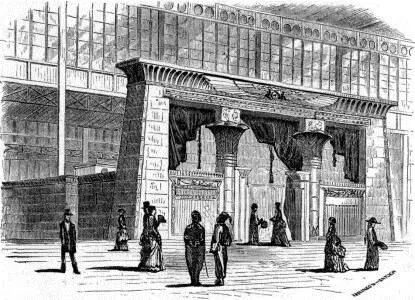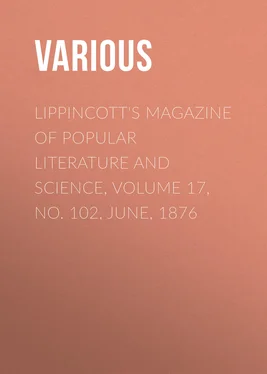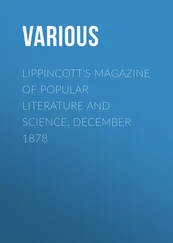Various - Lippincott's Magazine of Popular Literature and Science, Volume 17, No. 102, June, 1876
Здесь есть возможность читать онлайн «Various - Lippincott's Magazine of Popular Literature and Science, Volume 17, No. 102, June, 1876» — ознакомительный отрывок электронной книги совершенно бесплатно, а после прочтения отрывка купить полную версию. В некоторых случаях можно слушать аудио, скачать через торрент в формате fb2 и присутствует краткое содержание. Издательство: Иностранный паблик, Жанр: foreign_antique, periodic, foreign_edu, на английском языке. Описание произведения, (предисловие) а так же отзывы посетителей доступны на портале библиотеки ЛибКат.
- Название:Lippincott's Magazine of Popular Literature and Science, Volume 17, No. 102, June, 1876
- Автор:
- Издательство:Иностранный паблик
- Жанр:
- Год:неизвестен
- ISBN:нет данных
- Рейтинг книги:3 / 5. Голосов: 1
-
Избранное:Добавить в избранное
- Отзывы:
-
Ваша оценка:
- 60
- 1
- 2
- 3
- 4
- 5
Lippincott's Magazine of Popular Literature and Science, Volume 17, No. 102, June, 1876: краткое содержание, описание и аннотация
Предлагаем к чтению аннотацию, описание, краткое содержание или предисловие (зависит от того, что написал сам автор книги «Lippincott's Magazine of Popular Literature and Science, Volume 17, No. 102, June, 1876»). Если вы не нашли необходимую информацию о книге — напишите в комментариях, мы постараемся отыскать её.
Lippincott's Magazine of Popular Literature and Science, Volume 17, No. 102, June, 1876 — читать онлайн ознакомительный отрывок
Ниже представлен текст книги, разбитый по страницам. Система сохранения места последней прочитанной страницы, позволяет с удобством читать онлайн бесплатно книгу «Lippincott's Magazine of Popular Literature and Science, Volume 17, No. 102, June, 1876», без необходимости каждый раз заново искать на чём Вы остановились. Поставьте закладку, и сможете в любой момент перейти на страницу, на которой закончили чтение.
Интервал:
Закладка:
Various
Lippincott's Magazine of Popular Literature and Science, Volume 17, No. 102, June, 1876
THE CENTURY—ITS FRUITS AND ITS FESTIVAL
VI. THE DISPLAY—INTRODUCTORY
FAÇADE OF THE SPANISH DIVISION, MAIN BUILDING.
All things being ready for their reception, how were exhibits, exhibitors and visitors to be brought to the grounds? To do this with the extreme of rapidity and cheapness was essential to a full and satisfactory attendance of both objects and persons. In a large majority of cases the first consideration with the possessor of any article deemed worthy of submission to the public eye was the cost and security of transportation. Objects of art, the most valuable and the most attractive portion of the display, are not usually very well adapted to carriage over great distances with frequent transshipments. Porcelain, glass and statuary are fragile, and paintings liable to injury from dampness and rough handling; while an antique mosaic, like the "Carthaginian Lion," a hundred square feet in superficies, might, after resuscitation from its subterranean sleep of twenty centuries with its minutest tessera intact and every tint as fresh as the Phoenician artist left it, suffer irreparable damage from a moment's carelessness on the voyage to its temporary home in the New World. More solid things of a very different character, and far less valuable pecuniarily, though it may be quite as interesting to the promoter of human progress, exact more or less time and attention to collect and prepare, and that will not be bestowed upon them without some guarantee of their being safely and inexpensively transmitted. So to simplify transportation as practically to place the exposition buildings as nearly as possible at the door of each exhibitor, student and sight-seer became, therefore, a controlling problem.
In the solution of it there is no exaggeration in saying that the Centennial stands more than a quarter of a century in advance of even the latest of its fellow expositions. At Vienna a river with a few small steamers below and a tow-path above represented water-carriage. Good railways came in from every quarter of the compass, but none of them brought the locomotive to the neighborhood of the grounds. In the matter of tram-roads for passengers the Viennese distinguished themselves over the Londoners and Parisians by the possession of one . In steam-roads they had no advantage and no inferiority. At each and all of these cities the packing-box and the passenger were both confronted by the vexatious interval between the station and the exposition building—often the most trying part of the trip. Horsepower was the one time-honored resource, in '73 as in '51, and in unnumbered years before. Under the ancient divisions of horse and foot the world and its impedimenta moved upon Hyde Park, the Champ de Mars and the Prater, the umbrella and the oil-cloth tilt their only shield against Jupiter Pluvius, who seemed to take especial pleasure in demonstrating their failure, nineteen centuries after the contemptuous erasure of him from the calendar, to escape his power. It was reserved for the Philadelphia Commission to bring his reign (not the slightest intention of a pun) to a close. The most delicate silk or gem, and the most delicate wearer of the same, were enabled to pass under roof from San Francisco into the Main Building in Fairmount Park, and with a trifling break of twenty steps at the wharf might do so from the dock at Bremen, Havre or Liverpool. The hospitable shelter of the great pavilion was thus extended over the continent and either ocean. The drip of its eaves pattered into China, the Cape of Good Hope, Germany and Australia. Their spread became almost that of the welkin.
Let us look somewhat more into the detail of this unique feature of the American fair.
Within the limits of the United States the transportation question soon solved itself. Five-sixths of the seventy-four thousand miles of railway which lead, without interruption of track, to Fairmount Park are of either one and the same gauge, or so near it as to permit the use everywhere of the same car, its wheels a little broader than common. From the other sixth the bodies of the wagons, with their contents, are transferable by a change of trucks. The expected sixty or eighty thousand tons of building material and articles for display could thus be brought to their destination in a far shorter period than that actually allowed. Liberal arrangements were conceded by the various lines in regard to charges. Toll was exacted in one direction only, unsold articles to be returned to the shipper free. As the time for closing to exhibitors and opening to visitors approached the Centennial cars became more and more familiar to the rural watcher of the passing train. They aided to infect him, if free from it before, with the Centennial craze. Their doors, though sealed, were eloquent, for they bore in great black letters on staring white muslin the shibboleth of the day, "1776—International Exhibition—1876." The enthusiasm of those very hard and unimpressible entities, the railroad companies, thus manifesting itself in low rates and gratuitous advertising, could not fail to be contagious. Nor was the service done by the interior lines wholly domestic. Several large foreign contributions from the Pacific traversed the continent. The houses and the handicraft of the Mongol climbed the Sierra Nevada on the magnificent highway his patient labor had so large a share in constructing. Nineteen cars were freighted with the rough and unpromising chrysalis that developed into the neat and elaborate cottage of Japan, and others brought the Chinese display. Polynesia and Australia adopted the same route in part. The canal modestly assisted the rail, lines of inland navigation conducting to the grounds barges of three times the tonnage of the average sea-going craft of the Revolutionary era. These sluggish and smooth-going vehicles were employed for the carriage of some of the large plants and trees which enrich the horticultural department, eight boats being required to transport from New York a thousand specimens of the Cuban flora sent by a single exhibitor, M. Lachaume of Havana. Those moisture-loving shrubs, the brilliant rhododendra collected by English nurserymen from our own Alleghanies and returned to us wonderfully improved by civilization, might have been expected also to affect the canal, but they chose, with British taste, the more rapid rail. They had, in fact, no time to lose, for their blooming season was close at hand, and their roots must needs hasten to test the juices of American soil. Japan's miniature garden of miniature plants, interesting far beyond the proportions of its dimensions, was perforce dependent on the same means of conveyance.

FAÇADE OF THE EGYPTIAN DIVISION, MAIN BUILDING.
The locomotive was summoned to the aid of foreign exhibitors on the Atlantic as on the Pacific side, though to a less striking extent, the largest steamships being able to lie within three miles of the exposition buildings. It stood ready on the wharves of the Delaware to welcome these stately guests from afar, indifferent whether they came in squadrons or alone. It received on one day, in this vestibule of the exposition, the Labrador from France and the Donati from Brazil. Dom Pedro's coffee, sugar and tobacco and the marbles and canvases of the Société des Beaux-Arts were whisked off in amicable companionship to their final destination. The solidarity of the nations is in some sort promoted by this shaking down together of their goods and chattels. It gives a truly international look to the exposition to see one of Vernet's battle-pieces or Meissonier's microscopic gems of color jostled by a package of hides from the Parana or a bale of India-rubber.
Читать дальшеИнтервал:
Закладка:
Похожие книги на «Lippincott's Magazine of Popular Literature and Science, Volume 17, No. 102, June, 1876»
Представляем Вашему вниманию похожие книги на «Lippincott's Magazine of Popular Literature and Science, Volume 17, No. 102, June, 1876» списком для выбора. Мы отобрали схожую по названию и смыслу литературу в надежде предоставить читателям больше вариантов отыскать новые, интересные, ещё непрочитанные произведения.
Обсуждение, отзывы о книге «Lippincott's Magazine of Popular Literature and Science, Volume 17, No. 102, June, 1876» и просто собственные мнения читателей. Оставьте ваши комментарии, напишите, что Вы думаете о произведении, его смысле или главных героях. Укажите что конкретно понравилось, а что нет, и почему Вы так считаете.












